.

ISS01-S-006 (31 October 2000) --- A Soyuz spacecraft lifts off from the Baikonur Cosmodrome at 10:53 a.m. Kazakhstan time. Onboard were Expedition One commander William M. (Bill) Shepherd, Soyuz commander Yuri P. Gidzenko and Sergei K. Krikalev, flight engineer.
.

JSC2000-E-27301 (31 October 2000) --- Flight controllers in Houston's Mission Control Center follow the countdown to the Kazakhstan liftoff of the Soyuz, carrying the Expedition One crew.
.

ISS01-323-010 (8 November 2000) --- Early film documentation of the Expedition One crew members onboard the International Space Station (ISS) shows cosmonauts Sergei K. Krikalev (left) and Yuri P. Gidzenko at work in the Zvezda Service Module. Krikalev, flight engineer, and Gidzenko, Soyuz commander, represent the Russian Aviation and Space Agency. This is one of the first film images released from the Expedition One crew.
.
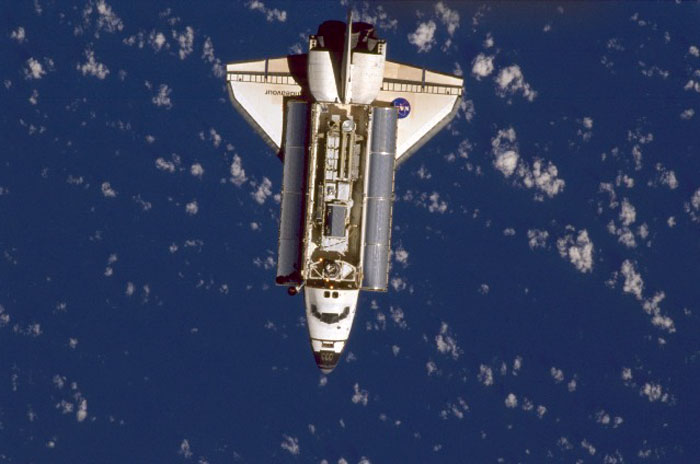
ISS01-326-018 (2 December 2000) --- This view of the Space Shuttle Endeavour approaching the International Space Station (ISS) was taken by one of the Expedition One crew members onboard the station.
.
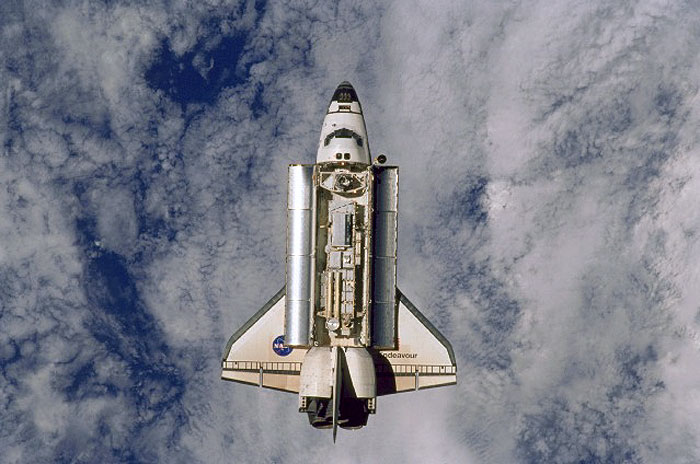
ISS01-326-020 (2 December 2000) --- This view of the Space Shuttle Endeavour approaching the International Space Station (ISS) was taken by one of the Expedition One crew members onboard the station.
.

ISS01-328-015 (4 December 2000) --- The Expedition One crew members are about to eat fresh fruit in the form of oranges onboard the Zvezda Service Module of the Earth-orbiting International Space Station (ISS). Pictured, from the left, are cosmonaut Yuri P. Gidzenko, Soyuz commander; astronaut William M. Shepherd, mission commander; and cosmonaut Sergei K. Krikalev, flight engineer.
.
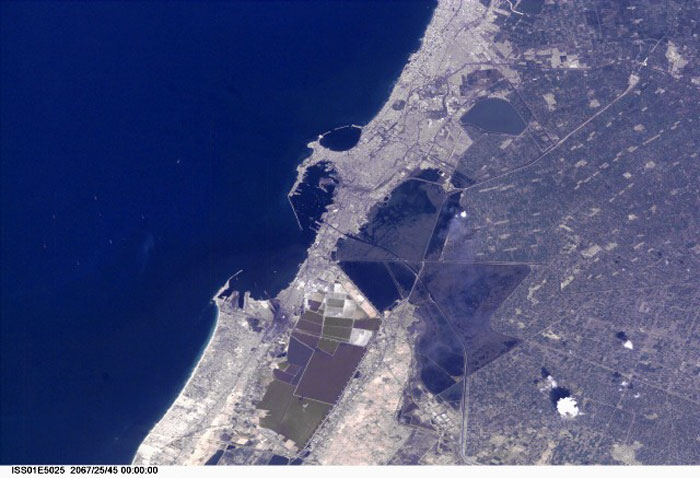
ISS01-E-5025 (November 2000) --- This Nadir view of Alexandria, Egypt, was provided by a digital still camera image down linked from the International Space Station to flight controllers in Houston. Alexandria (Al Iskandariya) occupies a T-shaped peninsula and strip of land separating the Mediterranean from Lake Mariout. According to NASA scientists studying the Expedition One photo collection, the town was originally built upon a mole (stone breakwater) called Heptastadium, which joined the island of Pharos to the mainland. Since then, the scientists say, sedimentary deposits have added considerably to the width of the mole. Since 1905, when the city's 370 thousand inhabitants lived in an area of about four square kilometers between the two harbors, the city (population 4 million) has grown beyond its medieval walls and now occupies an area of about 300 square kilometers. The Mahmudiya Canal, connecting Alexandria with the Nile, runs to the south of the city and, by a series of locks, enters the harbor of the principal port of Egypt (note ships). The reddish and ochre polygons west of Lake Mariout are salt-evaporation, chemical-storage, and water-treatment ponds within the coastal lagoon.
.
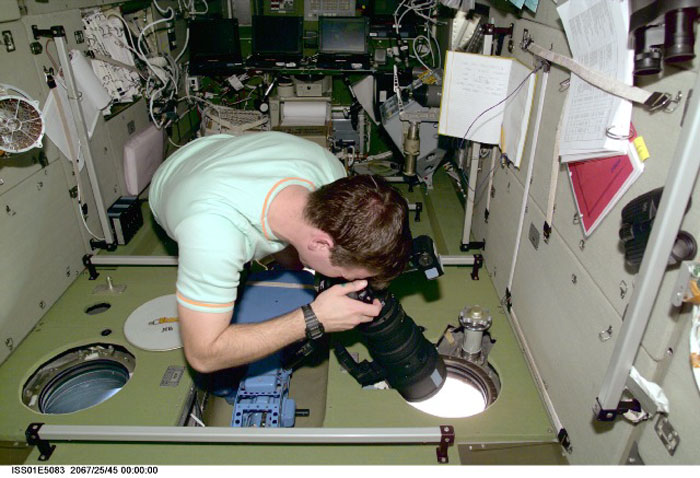
ISS01-E-5083 (December 2000) --- Cosmonaut Yuri P. Gidzenko, Expedition One Soyuz commander, takes a still photo of a geographic target of opportunity, through one of the viewing ports onboard the International Space Station's Zvezda Service Module.
.
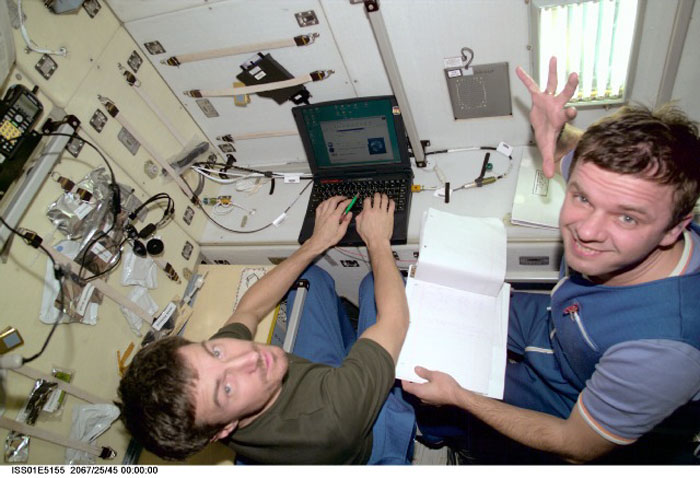
ISS01-E-5155 (December 2000) --- Cosmonauts Sergei K. Krikalev (left), Expedition One flight engineer, and Yuri P. Gidzenko, Soyuz commander, input data into a laptop computer in the Zvezda Service Module aboard the Earth-orbiting International Space Station (ISS).
.

ISS01-E-5316 (23 January 2001) -- Popocatépetl, or Popo, the active volcano located about 70 kilometers southeast of Mexico City, sends a plume south on January 23, 2001. The Expedition One crew onboard the International Space Station (ISS) observed and recorded this image with a digital still camera as it orbited to the northeast of the volcano. Popo has been frequently active for six years. On this day, the eruption plume reportedly rose to more than 9 kilometers above sea level (for reference, Popo's summit elevation is 5426 meters). Note the smaller ash plume below the main plume. The perspective from the ISS allowed the crew members this unique three dimensional view. Popo is situated between two large population centers: Mexico City (more than 18 million people, and just out of this image at right) and Puebla (about 1.2 million people), partially visible at lower left.
.

ISS01-E-5337 (12 February 2001) --- Astronaut Robert L. Curbeam, mission specialist, is pictured above the cargo bay of the Space Shuttle Atlantis during the second of three scheduled STS-98/5a space walks. The photo was taken with a digital still camera from inside the Destiny laboratory, newly added to the components of the International Space Station (ISS).
.
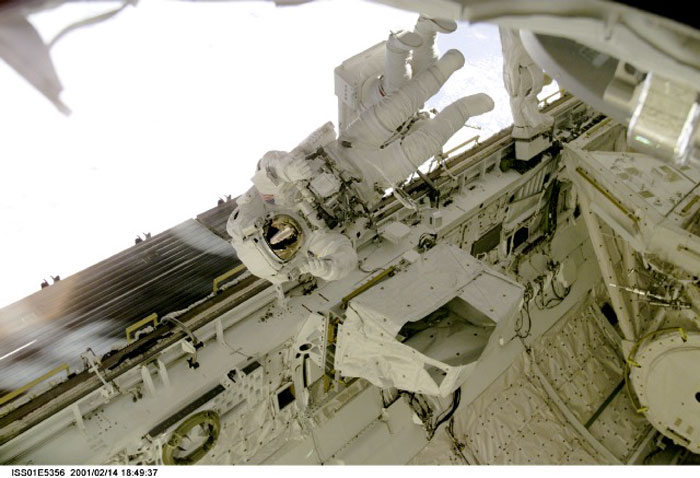
ISS01-E-5356 (14 February 2001) --- Astronaut Robert L. Curbeam, STS-98 mission specialist, floats above the longerons of the cargo bay on the Space Shuttle Atlantis during the final of three STS-98/5a space walks. Partially obscured behind Curbeam is astronaut Thomas D. Jones, his colleague and partner for all three walks. The scene was recorded with a digital still camera.
.

ISS01-E-5358 (14 February 2001) --- Astronauts Thomas D. Jones (red stripes on suit) and Robert L. Curbeam, STS-98 mission specialists, are pictured in the cargo bay of the Space Shuttle Atlantis during their third space walk, as photographed with a digital still camera from the International Space Station's new Destiny laboratory.
.

ISS01-E-5360 (14 February 2001) --- Astronauts Thomas D. Jones (partially obscured) and Robert L. Curbeam, STS-98 mission specialists, are pictured in the cargo bay of the Space Shuttle Atlantis during their third space walk, as photographed with a digital still camera from the International Space Station's new Destiny laboratory.
.

ISS01-E-5368 (14 February 2001) --- Onboard the new Destiny laboratory, Expedition One commander William M. (Bill) Shepherd, shares a brief break from a busy work agenda with astronaut Marsha S. Ivins, STS-98 mission specialist. The two are alumni of the tenth class of NASA astronaut candidates, having come aboard with 15 other trainees in the summer of 1984.
.

ISS01-E-5385 (16 February 2001) --- The Space Shuttle Atlantis was photographed by the three-man Expedition One crew aboard the International Space Station (ISS) shortly after the shuttle and the outpost unlinked following several days of joint operations of the two crews. The scene, backdropped against a mass of white clouds on Earth, was recorded with a digital still camera.
,
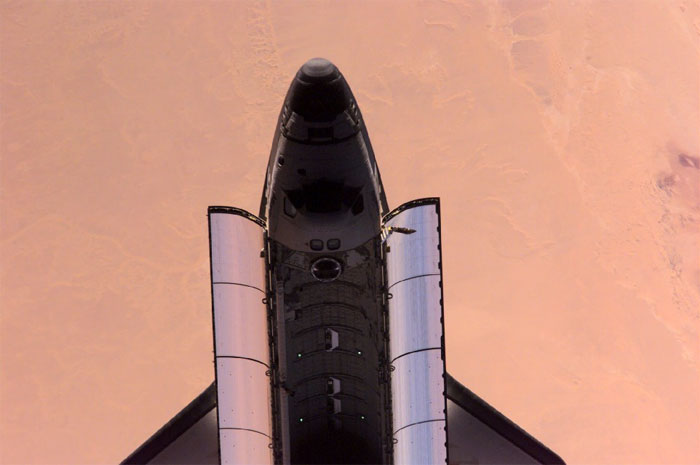
ISS01-E-5387 (16 February 2001) --- This nadir image of the Space Shuttle Atlantis backdropped over a desert was photographed by the three-man Expedition One crew aboard the International Space Station (ISS) shortly after the shuttle and the outpost unlinked following several days of joint operations of the two crews. The scene was recorded with a digital still camera.
.
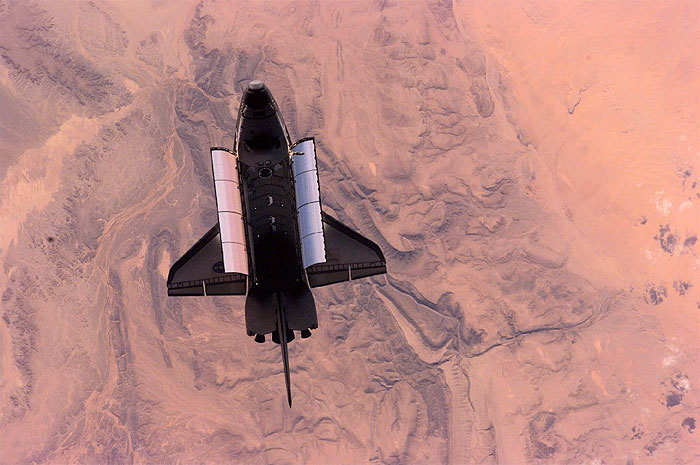
ISS01-E-5390 (16 February 2001) --- This high-angle image of the Space Shuttle Atlantis backdropped over a desert was photographed by the three-man Expedition One crew aboard the International Space Station (ISS) shortly after the shuttle and the outpost unlinked following several days of joint operations of the two crews. The scene was recorded with a digital still camera.
.

ISS01-E-5392 (16 February 2001) --- This high-angle image of the Space Shuttle Atlantis backdropped over a mountainous coastline was photographed by the three-man Expedition One crew aboard the International Space Station (ISS) shortly after the shuttle and the outpost unlinked following several days of joint operations of the two crews. The scene was recorded with a digital still camera.
.

ISS01-E-5396 (16 February 2001) --- This rarely seen image of the underside of the Space Shuttle Atlantis was photographed by the three-man Expedition One crew aboard the International Space Station (ISS) after the shuttle and the outpost unlinked following several days of joint operations of the two crews. The scene was recorded with a digital still camera.
.

ISS01-361-017 (9 February 2001) --- Cosmonaut Sergei K. Krikalev, flight engineer for Expedition One, is positioned at a port hole on the Zvezda service module of the International Space Station (ISS) as the Space Shuttle Atlantis approaches for a link-up leading to several days of joint activities between the two crews. The crew cabin and forward section of the Space Shuttle Atlantis can be seen in the window. The aft part of the cargo bay, where the Destiny laboratory was stowed, is not visible in the scene. Scattered clouds over the Western Pacific are visible in the window scene.
.

ISS01-376-004 (12 February 2001) --- Astronaut Robert L. Curbeam, STS-98 mission specialist, was photographed by a member of the Expedition One crew in the newly installed Destiny laboratory during the second of three space walks. With all of the tasks planned for the second space walk completed, and still time available, the astronauts moved to tasks that had originally been planned for the third extravehicular activity (EVA) period on the flight. Ahead of schedule, they connected several computer and electrical cables between the docking port and the lab; unveiled the lab's large, high-quality window (through which this photo was taken) and attached an exterior shutter; and repositioned a movable foot platform they had taken inside Atlantis on the first spacewalk for a slight adjustment.
.

ISS01-E-6128 (9 February 2001) --- Atlantis was photographed from the International Space Station (ISS) prior to link-up with international outpost at 10:50 a.m. (CST), Feb. 9, 2001, as the two craft flew over the Western Pacific northeast of New Guinea. About ninety minutes later, hatches were swung open between Atlantis and the ISS, enabling the two crews to greet each other and transfer critical gear before re-closure later in preparation for the first (Feb. 10) of three planned space walks to help in the installation and hookup of Destiny on the Station. The photograph was taken with a digital still camera.
.

JSC2001-E-08313 (22 March 2001) --- Astronaut William M. (Bill) Shepherd (center), Expedition One mission commander, is flanked by his two cosmonaut crewmates as they greet a crowd gathered for a crew return ceremony in Ellington Field's Hangar 990. Yuri P. Gidzenko (right foreground) served as Soyuz commander for the first staffing of the International Space Station (ISS) and Sergei K. Krikalev (left) was flight engineer.
.
Fotos: NASA
6322 Views
